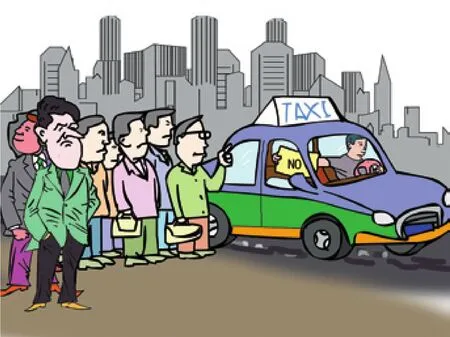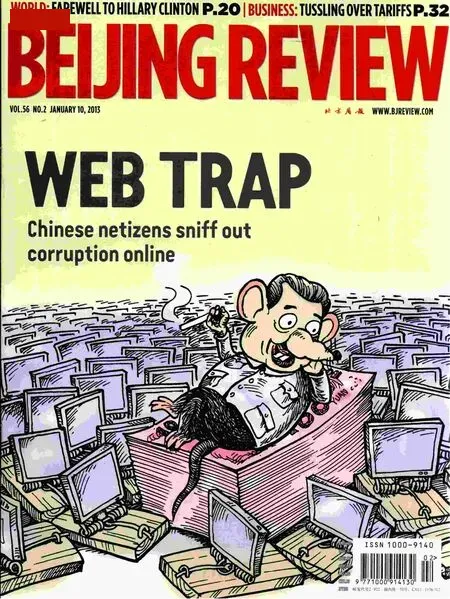How to Make It Easier to Take a Taxi?
2013-12-06
Take Beijing for example, the city is currently experiencing its coldest winter in a decade,complete with snow and freezing temperatures, which adds to the problem. Most would agree that waiting for a taxi in sub-zero degree weather is a torture.
In fact, the issue has long been a heated topic for debate, prompting the necessity for effective solutions. The following are media excerpts of some ideas:
Li Zheng (People’s Daily):Why is it so difficult to catch a taxi? On the whole, it’s because of the lack of services. Every year, Beijing receives many new permanent and temporary residents, but overall taxi numbers remain at around 67,000. Given such a serious imbalance of supply and demand, it’s almost impossible not to encounter problems.
Digging deeper, we approach the core of the question: the high threshold for taxis to enter business. Taxi services belong to a special sector where the number of cabs are determined by the amount of licenses issued by authorities. Strict control over taxi operations directly results in a severe imbalance.
It’s widely agreed that peak hours are the most difficult times to catch a cab because too many people compete at this point. However,the fact is, many taxi drivers refuse to pick up passengers during rush hour. Subsequent questioning has led to in-depth problems concerning the pricing mechanism and profit distribution system.
Taxi drivers have to pay management fees to their companies. In addition, although gasoline subsidies fall far short of the rise in oil prices,taxi fees usually fail to rise in accordance. Such problems make taxi driving a tough business with little pro fit. Therefore, during rush hour and terrible weather, drivers naturally refuse to operate.
缩微智能车路径跟踪的增量式PID控 制 ……………………………… 何俊龙,杜 峰,关志伟,张 羽(5)
Since we’ve uncovered the root of the problem, is it possible for the government to relax its control over and expand the market?A better division of pro fits could further entice people to this type of occupation.
If the government lets go its grip on the taxi business, chaos might ensue due to messy competition. Thus, it’s not the ideal option.However, the problem can be tackled by making pro fit distribution more reasonable to follow market rules.
Zhang Guohua (First Financial Daily):Taxis are one of the major transport tools in many cities. That is why the difficulty in taking taxis is such a big concern for so many people.
Low interest among taxi drivers in picking up passengers, particularly during rush hour, is to a large extent related to their poor income.In Beijing, drivers have to pay their companies 5,000 yuan to 6,000 yuan ($794-$953) before they profit themselves. With so much money turned in, enthusiasm for the work is severely undermined.
Some experts point out that taxi prices in Beijing are much lower than in other international cities. Thus, it’s necessary to change current pricing standards, raising fees for every km during rush hour to stir driver interest in doing a good job.
Han Han (The Beijing News):Unlike most cities, taxis are widely used and not only reserved for a privileged few in Beijing.
According to a Chinese Academy of Social Sciences report issued on December 20, 2012,Beijing ranks 28th among 38 big Chinese cities in terms of the ease of taking a taxi. Around 8.48 percent of respondents said it often took over half an hour to hail a cab while 45.29 percent took 10 to 30 minutes.
Dissatisfaction has accumulated over time,but the problem remains. Though the government has tried to prohibit taxi drivers from refusing passengers, penalty measures alone are not enough to solve the dilemma. In addition, traffic congestion, the absence of spec ific standards, inef ficient law enforcement and the lack of service innovation all need to be properly addressed.
In Beijing, the amount of commuters outnumber the availability of services. Since the transport system cannot yet meet demand, and the ownership of private cars is strictly limited,taxis should be incorporated as a major part of the public transport system, rather than be kept as a complement.
Strict limitation on the number of taxis should be adjusted. In the past decade, as demand for taxi services increased, the number of cabs has remained the same. In some sense,consideration should be given to moderately expand services by district, according to demand.
Traf fic congestion is a primary concern.As a component of public transport, taxis should be afforded the same treatment as bus services, for example, in the use of special lanes. The government should additionally help increase the number of cabs during bad weather. Taxi companies should be held accountable for mismanaged operations during peak travel periods.
If passengers head in the same destination, sharing a taxi is a good idea. In cities like Chongqing and Changsha, display screens installed inside taxis indicate direction and the number of passengers for convenience.
In addition, practices such as picking and choosing between passengers, which are becoming increasingly widespread, should be strictly punished and monitored.
The increasing difficulty of hailing a taxi affects quality of life and urban development.Only by intelligent positioning can this problem be addressed.
Chen Zhenning (www.singpao.com): It is becoming increasingly difficult to take a taxi in Beijing, especially during rush hour. The freezing cold this winter only highlights the urgency to solve the problem.
There are around 67,000 taxis in Beijing,and it is predicted that the figure will not experience massive expansion until 2015. Obviously,there is a gap between supply and demand.

In addition, the number of taxis in Beijing is strictly controlled by the government while taxi companies fiercely oppose increasing numbers in case their profits are affected, which can explain why illegal services still thrive in the city. Nevertheless, the increasing number of underground cabs only adds to the already complicated situation.
To counter widespread congestion, the Municipal Government of Beijing has carried out a vehicle restriction rule based on the last digit on the license plate for years, by which cars are banned for use in urban areas one work-day a week.
To deal with the difficulty of hailing a cab,some call for boosting fees in order to balance the demand for taxis and other public transport services. Of course, such measures will undoubtedly result in opposition from local residents and greater price pressure on other transportation means.
Second, illegal cabs should be recruited into the ranks of normal services, taking the livelihood of existing taxi drivers into account.
Third, complaints should be strictly dealt with to prevent repeat occurrence.
Fourth, taxis should be managed by district,as in Hong Kong, where services are divided between the downtown area. In this way, the number of taxis in each district can be accurately allocated.
Cheng Zhe (www.cet.com.cn):There is disagreement between passengers and drivers on this issue. Passengers believe increasing cabs, strengthening management and improving phone reservation services are the fundamental solutions, while taxi drivers call for more individuals to be included in the market,so that they don’t have to pay their daily fees to companies.
Some say that the current dilemma is caused by the lagging of reforms in the sector. In tackling powerful vested interests, the government should pluck up courage to further change, making the market admittance,management and operating mechanism more compatible with demand.
Moreover, the government should strengthen efforts to develop the public transportation system and formulate a long-term strategy. ■
